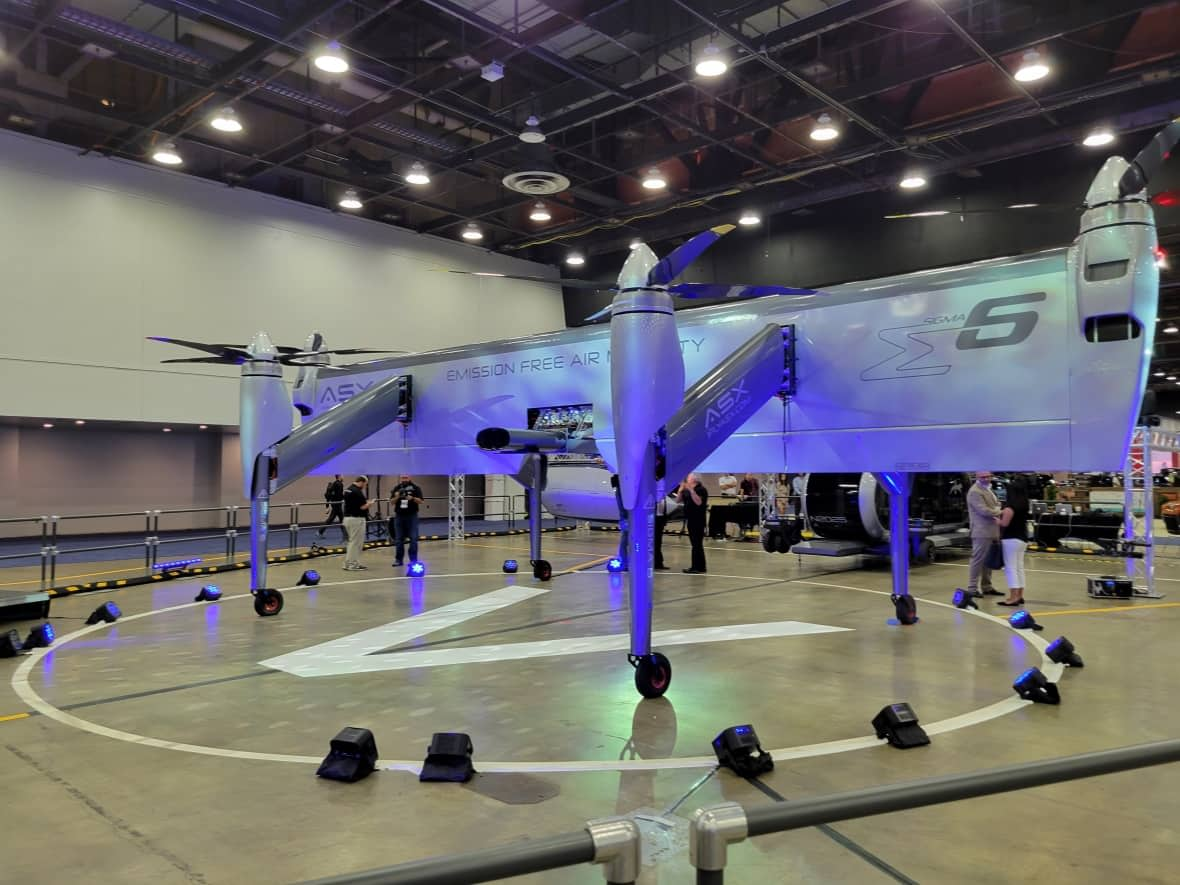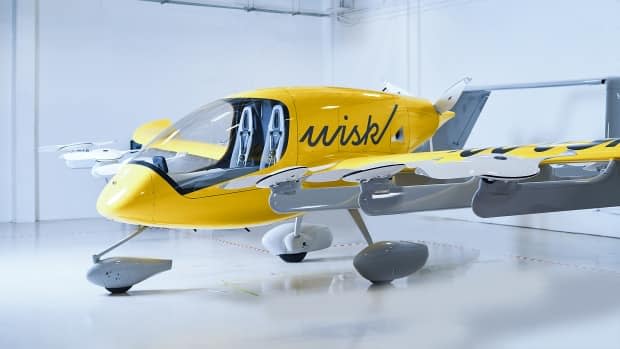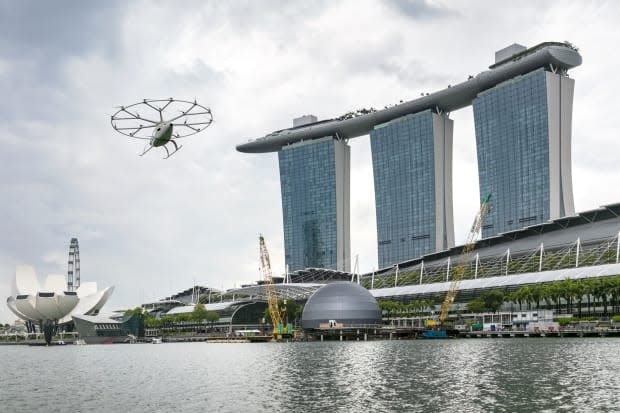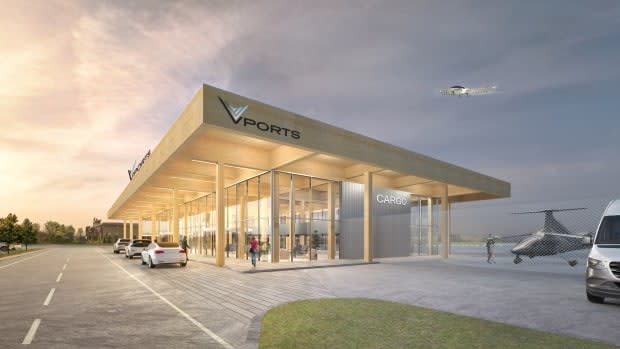Are electric air taxis ready for takeoff? Maybe sooner than you think

Imagine you're about to order an Uber to the airport, but there's terrible traffic. Instead, you click "air taxi" on your smartphone, and walk a few blocks to a parking garage. You head up to the roof, where an aircraft that looks like a giant drone picks you up.
Within minutes, it drops you and a handful of other passengers at the airport to catch your flight.
That's the potential of eVTOLs, or electric vertical takeoff and landing aircraft — and the aviation industry says it won't be long before they take to the skies commercially.
These battery-powered aircraft will move cargo and passengers between the city, the suburbs, and airports, says Jon Rimanelli, CEO of Airspace Experience Technologies.
His Detroit-based company is one of dozens building eVTOLs, technology that's getting more attention as cutting greenhouse gas emissions from burning fossil fuels becomes a global priority.

"Traffic is a big problem, right? It's not only taking up our time and anxiety, it's creating carbon emissions … it's hurting our environment," he says. "We have to do something different."
Air taxis still have a limited range because of their battery capacity, but some can cover a distance of about 250 kilometres. They generally take off and land anywhere a helicopter can, so they don't need a runway, and many are pilot-optional and can be flown remotely. They also make little noise as they travel.
Rimanelli hopes it won't take much to win over the public.
"Once people see the utility of it, once they have a chance to experience it because it's super quiet…. It's just a tremendous difference between commercial grade helicopters that we all know today."
Rimanelli predicts some eVTOLs will first be used for deliveries, before they actually transport passengers. His prototype, which was on display at this year's Detroit Auto Show, is designed with a pod that can carry goods or people.
"We're more flexible. We can plug and play different containers to do different jobs, whether it's medical evacuation, cargo or passenger mobility," he says.
WATCH | Electric aircraft companies aim to revolutionize the delivery goods and people:
Making big bets
The aviation industry is betting millions of dollars air taxis will play a big role in the future of transportation.
Over the past few months, U.S. carrier United Airlines ordered 200 air taxis from Eve Air Mobility and another 100 from Archer Aviation. American Airlines had an agreement for 250 from Vertical Aerospace. Last year, Canadian helicopter operator Helijet inked a deal with Blade Air Mobility. The partnership gives Blade the rights to Helijet's routes and infrastructure, and Helijet access to Blade's air taxis.

Automakers are also showing interest in the eVTOL space, which has significant overlaps with electric vehicles. They are already pouring money into developing EV batteries. Hyundai, GM and Volkswagen are all working on developing their own air taxi prototypes. Automakers can offer air taxi-makers manufacturing expertise as well. Daimler has partnered with Volocopter, while Joby Aviation counts Toyota as a major investor.
Analysts say the opportunity is there: consulting firm McKinsey predicts that by 2030, air taxis could be a multi-billion dollar market. But costs will need to come down for broader adoption; some eVTOLS still cost upwards of $1 million.
Competition is stiff among hundreds of startups and not every company will survive. Just this week, Kittyhawk, an air taxi-maker backed by Google co-founder and billionaire Larry Page, announced on Twitter that it would be winding down its business.
New regulations on the drawing board
While the technology is rapidly maturing, there's still much work to be done on the regulatory side.
"There's going to have to be some form of air traffic control and pilot certifications and operational requirements," says Nigel Waterhouse, an aerospace consultant.
Regulators around the world are evaluating the new machines. With plans to fly at low altitudes in urban areas, there are significant safety concerns. Officials in the European Union recently published what they called the world's first rules for the operation of air taxis. The U.S. Federal Aviation Administration is working on certification for several eVTOL companies, some hoping to have paying customers as soon as 2024.

Waterhouse says it may be slow-going. "These companies that are developing these aircraft are quite ahead of the curve and the FAA is trying to catch up, but they are trying to be more flexible in applying the rules," he says.
Meanwhile, Transport Canada told CBC News that while it doesn't currently have standards, it will "review and update its regulatory framework as necessary to ensure that its high safety standard is maintained."
Manufacturers like Rimanelli insist their designs are safer compared to helicopters.
"Because it's electric, it's a simple machine," he says. "Fewer failure modes, fewer parts. So that's one of the key benefits to a system like this, it's inherently more reliable."
But it's not just regulators that need convincing, Waterhouse says. "It's going to be an exercise for the operators to sell the idea to the public and to make them feel safe in these aircraft... So that may be a fairly steep curve."
If you build it, they will come
Cities and suburbs will also need infrastructure to support air taxis, if this new type of mobility is to take off. Some startups are tackling that challenge with plans to build terminals called vertiports. Vertiports would offer air taxis a place to take off and land, and charge their batteries.

Montreal-based VPorts hopes to build and operate a network of 1,500 vertiports for commercial cargo transportation over the next two decades, starting with a corridor between Canada and the U.S., says CEO Fethi Chebil. "Cargo is a very important business and we believe that by having this corridor we will reduce the cost of ... the transport of goods between the two countries by 10 per cent," says Chebil.
Chebil says eVTOL test flights are planned for the corridor next year. When asked about the timelines for passenger transportation, he says the technology has to evolve but "when you and me fly in a couple of years, we can fly safely. You'll be surprised."
With files from Shawn Benjamin


